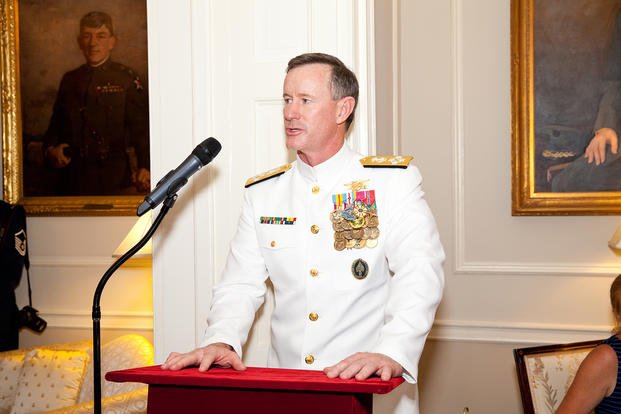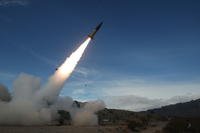ABERDEEN PROVING GROUND, Md. -- The U.S. Special Operations Command is using unprecedented outreach and collaboration to develop something special with revolutionary capabilities.
The Tactical Assault Light Operator Suit, or TALOS, is the vision of Navy Adm. William H. McRaven, SOCOM's commander. He challenged industry and defense representatives at a SOCOM conference in May 2013 to come up with the concepts and technologies to make the suit a reality. The goal is to offer operators better protection, enhanced performance and improved situational awareness.
McRaven spoke more recently at a February 2014 National Defense Industry Association Special Operations/Low Intensity Conflict symposium in Washington, D.C.
"The TALOS program is a collaboration of efforts," McRaven said. "We are teaming with 56 corporations, 16 government agencies, 13 universities and 10 national laboratories, and we are leveraging the expertise of leading minds throughout the country to redefine the state of the art in survivability and operator capability.
"This innovative approach brings together the brightest minds in a national effort, and we are already seeing astounding results in this collaboration. If we do TALOS right, it will be a huge comparative advantage over our enemies and give our warriors the protection they need in a very demanding environment."
Exactly what capabilities the TALOS will deliver is not yet clear, explained Michael Fieldson, SOCOM's TALOS project manager. The goal is to provide operators lighter, more efficient full-body ballistics protection and super-human strength. Antennas and computers embedded into the suit will increase the wearer's situational awareness by providing user-friendly and real-time battlefield information.
Integrated heaters and coolers will regulate the temperature inside the suit. Embedded sensors will monitor the operator's core body temperature, skin temperature, heart rate, body position and hydration levels. In the event that the operator is wounded, the suit could feasibly start administering the first life-saving oxygen or hemorrhage controls.
Fieldson admitted that the analogy to the suit that the Tony Stark character wore in the "Iron Man" movies may be a bit of a stretch. The TALOS, for example, isn't expected to fly.
But beyond that, there's little that Fieldson -- or anyone else at SOCOM -- is ready to rule out.
In a departure from past practices of introducing new products piecemeal, adding bulk and weight to operators' kit, the TALOS will be a fully integrated "system of systems," Fieldson said. To offset the weight of computers, sensors and armor that make up the suit, operators will have an exoskeleton -- a mechanism that carries the brunt of the load.
"The intent is to have this fully integrated system so you can provide the most capability at the lowest impact to the soldier," Fieldson said. "We think there is some efficiency to be gained if all the equipment is fully integrated, as opposed to different components that are simply assembled on the human."
Keeping the systems and the exoskeleton powered will require more than today's batteries can deliver. So along with the TALOS technologies, SOCOM is calling on the scientific and technical community to come up with reliable and portable power sources.
"We are really looking at stretching the bounds of science and technology," Fieldson said.
That led SOCOM to reach out to partners within the Defense Department as well as industry and academia for help in pushing today's technological limits.
The command is working with the Defense Advanced Research Projects Agency, known as DARPA; the U.S. Army Research, Development and Engineering Command, or RDECOM; and centers such as in Natick, Massachusetts, and the Army Research Laboratory in Adelphi, Maryland, among other DoD organizations, to tap into projects already underway.
DARPA, for example, is making headway on its Warrior Web project, designed to boost troops' stamina and carrying capacity without sacrificing speed or agility. The concept includes a lightweight undersuit that would augment the efforts of the wearer's own muscles.
"Many of the individual technologies currently under development show real promise to reduce injury and fatigue and improve endurance," said Lt. Col. Joseph Hitt, DARPA's Warrior Web program manager. "Now we're aiming to combine them -- and hopefully some new ones, too -- into a single system that nearly every soldier could wear and would provide decisive benefits under real-world conditions."
The Natick lab is busy identifying high-technology armor and mobility technologies with plans to integrate them into a first-generation TALOS system ready for demonstration by the end of June, said Greg Kanagaki, project engineer for Natick's Unmanned Equipment and Human Augmentation Systems Team.
Natick personnel also are serving as subject-matter experts for the TALOS project, particularly in the areas of mobility, human performance and thermal management, Kanagaki said.
Meanwhile, RDECOM officials say their programs have a direct application to TALOS as well.
"[The] requirement is a comprehensive family of systems in a combat armor suit where we bring together an exoskeleton with innovative armor, displays for power monitoring, health monitoring and integrating a weapon into that -- a whole bunch of stuff that RDECOM is playing heavily in," said Army Lt. Col. Karl Borjes, the command's science adviser.
"RDECOM cuts across every aspect making up this combat armor suit. It's advanced armor. It's communications, antennas. It's cognitive performance. It's sensors, miniature-type circuits. That's all going to fit in here, too."
SOCOM has called on the private sector, too, inviting not just its traditional industry partners, but also those who previously never worked with the command to participate in the TALOS program.
"There is no one industry that can build it," SOCOM's senior enlisted adviser, Army Command Sgt. Maj. Chris Faris, said during a panel discussion at the command's MacDill Air Force Base, Florida, headquarters, as reported by the Defense Media Network.
The outreach has generated a lot of interest. SOCOM's TALOS planning session this past summer attracted representatives of 80 colleges, 10 universities and four national laboratories. At a demonstration in July, 80 companies demonstrated technologies ranging from advanced body armor, some using liquids that turn solid on impact, to power supplies to exoskeleton mechanisms.
SOCOM's goal is to have a TALOS prototype within the next year and to have the suit ready for full field testing within five years, Fieldson said. That timetable is revolutionary for the military research, development and acquisition world, even for rapid-equipping programs.
As the only combatant command with acquisition authority, SOCOM is able to accelerate the TALOS project, Fieldson said. The command's acquisition executive and research and development staff share a building at MacDill Air Force Base, which he said promotes close collaboration and speedy decision-making.
"We have access that is nontraditional, and that absolutely helps us," Fieldson said. "We can bounce ideas back and forth against the leadership and ensure that what we are doing makes sense. That is critical to trying to develop this system within the timeline we are working toward."
Also, in a departure from traditional development projects, SOCOM's Acquisition Center staff established an innovation cell to lead the effort, advised by operators and focused on transforming business processes to solve the extreme integration challenges associated with TALOS.
"Because of the technical challenges and the compressed timeline, we are going to take more ownership on the government side than we typically take," Fieldson said.
"We are going to go in and make some decisions that we sometimes rely on industry partners to make for us. That allows us to reach out to a broader audience. That way, if there is a great idea in some nontraditional organization, we can integrate it" without relying on a commercial company to do so.
"We are really changing the process," Fieldson said. "And the reason we are doing that is to try to streamline the overall effort and drive down both the cost and the schedule. That way, we get the best possible equipment to our force as quickly as possible."
Although the TALOS initially is intended for special operators involved in high-risk missions, it has implications for the conventional force as well, Fieldson said.
"We have a long history at SOCOM of developing things first and then the technology moving out to the broader force," he said. "We fully expect that to happen with this one as well. There will be a lot of spinoff technologies that the broader force will be able to use."
Meanwhile, McRaven remains the suit's No. 1 proponent.
"I'm very committed to this," he told industry representatives at a July planning forum. "I'd like that last operator that we lost to be the last operator we lose in this fight or the fight of the future. And I think we can get there."
Navy Capt. Kevin Aandahl, U.S. Special Operations Command, contributed to this article.
U.S. Army Research, Development and Engineering Command is a major subordinate command of the U.S. Army Materiel Command. AMC is the Army's premier provider of materiel readiness -- technology, acquisition support, materiel development, logistics power projection, and sustainment -- to the total force, across the spectrum of joint military operations. If a Soldier shoots it, drives it, flies it, wears it, eats it or communicates with it, AMC provides it.
Want to Know More About the Military?
Be sure to get the latest news about the U.S. military, as well as critical info about how to join and all the benefits of service. Subscribe to Military.com and receive customized updates delivered straight to your inbox.











